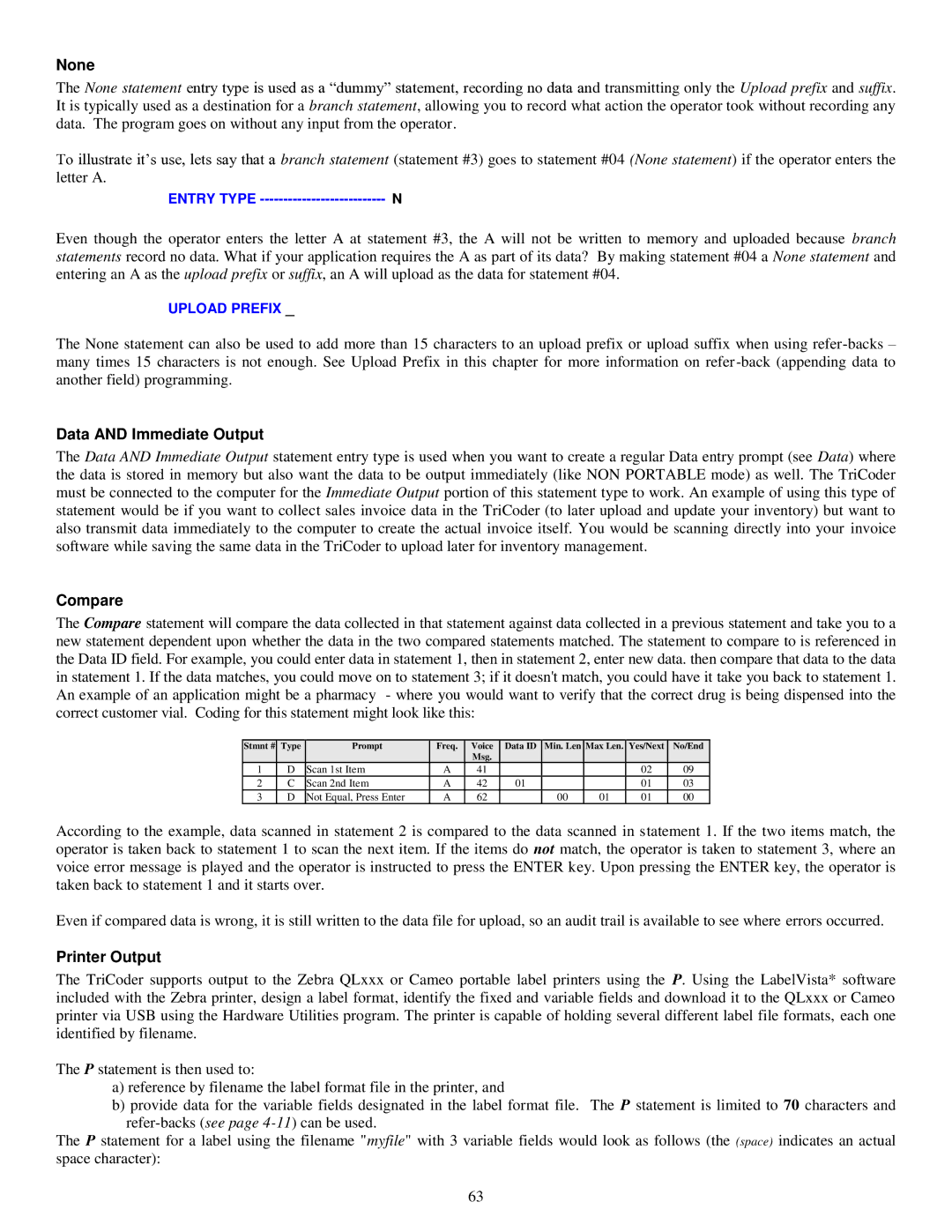None
The None statement entry type is used as a “dummy” statement, recording no data and transmitting only the Upload prefix and suffix. It is typically used as a destination for a branch statement, allowing you to record what action the operator took without recording any data. The program goes on without any input from the operator.
To illustrate it‟s use, lets say that a branch statement (statement #3) goes to statement #04 (None statement) if the operator enters the letter A.
ENTRY TYPE | N |
Even though the operator enters the letter A at statement #3, the A will not be written to memory and uploaded because branch statements record no data. What if your application requires the A as part of its data? By making statement #04 a None statement and entering an A as the upload prefix or suffix, an A will upload as the data for statement #04.
UPLOAD PREFIX _
The None statement can also be used to add more than 15 characters to an upload prefix or upload suffix when using
Data AND Immediate Output
The Data AND Immediate Output statement entry type is used when you want to create a regular Data entry prompt (see Data) where the data is stored in memory but also want the data to be output immediately (like NON PORTABLE mode) as well. The TriCoder must be connected to the computer for the Immediate Output portion of this statement type to work. An example of using this type of statement would be if you want to collect sales invoice data in the TriCoder (to later upload and update your inventory) but want to also transmit data immediately to the computer to create the actual invoice itself. You would be scanning directly into your invoice software while saving the same data in the TriCoder to upload later for inventory management.
Compare
The Compare statement will compare the data collected in that statement against data collected in a previous statement and take you to a new statement dependent upon whether the data in the two compared statements matched. The statement to compare to is referenced in the Data ID field. For example, you could enter data in statement 1, then in statement 2, enter new data. then compare that data to the data in statement 1. If the data matches, you could move on to statement 3; if it doesn't match, you could have it take you back to statement 1. An example of an application might be a pharmacy - where you would want to verify that the correct drug is being dispensed into the correct customer vial. Coding for this statement might look like this:
Stmnt # | Type | Prompt | Freq. | Voice | Data ID | Min. Len | Max Len. | Yes/Next | No/End |
|
|
|
| Msg. |
|
|
|
|
|
1 | D | Scan 1st Item | A | 41 |
|
|
| 02 | 09 |
2 | C | Scan 2nd Item | A | 42 | 01 |
|
| 01 | 03 |
3 | D | Not Equal, Press Enter | A | 62 |
| 00 | 01 | 01 | 00 |
According to the example, data scanned in statement 2 is compared to the data scanned in statement 1. If the two items match, the operator is taken back to statement 1 to scan the next item. If the items do not match, the operator is taken to statement 3, where an voice error message is played and the operator is instructed to press the ENTER key. Upon pressing the ENTER key, the operator is taken back to statement 1 and it starts over.
Even if compared data is wrong, it is still written to the data file for upload, so an audit trail is available to see where errors occurred.
Printer Output
The TriCoder supports output to the Zebra QLxxx or Cameo portable label printers using the P. Using the LabelVista* software included with the Zebra printer, design a label format, identify the fixed and variable fields and download it to the QLxxx or Cameo printer via USB using the Hardware Utilities program. The printer is capable of holding several different label file formats, each one identified by filename.
The P statement is then used to:
a)reference by filename the label format file in the printer, and
b)provide data for the variable fields designated in the label format file. The P statement is limited to 70 characters and
The P statement for a label using the filename "myfile" with 3 variable fields would look as follows (the (space) indicates an actual space character):
63
